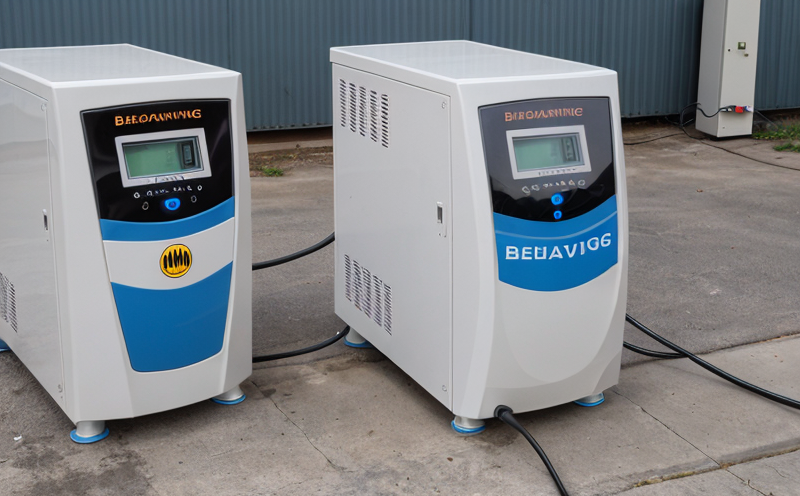EN 62619 Charging and Discharging Testing of Industrial Lithium Batteries
The European standard EN 62619 outlines comprehensive procedures for the testing of charging and discharging behavior in industrial lithium batteries. This critical procedure ensures that batteries meet stringent performance requirements, enhancing safety, reliability, and efficiency in various sectors such as transportation, renewable energy storage, and telecommunications.
EN 62619 covers a wide range of tests designed to evaluate the charging and discharging characteristics of industrial lithium batteries. This includes determining the maximum charge capacity, discharge performance at different temperatures, and assessing the impact of repeated cycles on battery life. The standard aims to ensure that batteries perform consistently under real-world conditions.
The testing process involves several key steps: initial setup, charging, discharging, and final analysis. During these tests, various parameters are closely monitored, including voltage, current, temperature, and internal resistance. Specimen preparation is critical; this involves selecting the appropriate type of battery cell that matches the expected usage environment.
The equipment used for EN 62619 testing typically includes high-precision chargers and discharge testers capable of simulating real-world conditions. These instruments must be calibrated regularly to ensure accurate results. The test setup often involves environmental chambers to control temperature, which can significantly affect battery performance.
One of the most important aspects of this testing is ensuring that the batteries meet the specified acceptance criteria outlined in EN 62619. This includes maintaining a high level of consistency across multiple charging and discharging cycles without significant degradation in capacity or efficiency. The standard also emphasizes the importance of safety, ensuring that batteries do not overheat or exhibit other hazardous behaviors during testing.
Another critical factor is understanding the implications of different charging rates on battery performance. Faster charging can lead to increased heat generation and potential damage if not managed properly. Therefore, the test protocols in EN 62619 include detailed procedures for safely accelerating the charge rate while monitoring temperature and voltage.
The results of these tests are meticulously recorded and analyzed to provide a comprehensive report on the battery's performance characteristics. This information is invaluable for quality managers and R&D engineers, helping them make informed decisions about product development and quality assurance processes.
For procurement teams, understanding EN 62619 compliance ensures that they select batteries that meet the necessary standards, reducing the risk of purchasing substandard products that could fail in critical applications. The detailed testing procedures outlined in this standard provide a robust foundation for ensuring consistent battery performance across diverse industrial applications.
The application of EN 62619 extends beyond just compliance; it also drives innovation by providing a clear benchmark against which new technologies can be evaluated. This ensures that the industry remains competitive and continues to meet evolving demands in terms of efficiency, safety, and reliability.
Applied Standards
The European standard EN 62619 is widely recognized for its comprehensive approach to testing charging and discharging behavior in industrial lithium batteries. This standard integrates various aspects of battery performance, including safety, efficiency, and reliability.
EN 62619 is closely aligned with other international standards such as ISO/IEC 60364-7-45, which provides guidelines for the application of lithium-ion batteries in industrial environments. Compliance with these standards ensures that battery performance meets global safety and quality requirements.
The standard also references EN 12978, which addresses the safety aspects of rechargeable cells used in portable electronic devices. By adhering to these international guidelines, manufacturers can ensure their products are safe and reliable across different markets.
EN 62619 specifically targets industrial lithium batteries, covering a broad spectrum of applications from energy storage systems to electric vehicles. The standard provides detailed protocols for testing the charging and discharging behavior under various conditions, ensuring that the batteries perform consistently and safely in real-world scenarios.
Industry Applications
- Energy Storage Systems: Industrial lithium batteries tested according to EN 62619 are essential for large-scale energy storage systems, providing reliable power during peak demand periods.
- Electric Vehicles: Ensuring the safe and efficient charging of electric vehicle batteries is critical. EN 62619 testing helps in achieving this by simulating real-world conditions.
- Telecommunications Infrastructure: Lithium batteries used in backup power supplies for telecom towers must undergo rigorous testing to ensure they can sustain operations during extended power outages.
Customer Impact and Satisfaction
The implementation of EN 62619 charging and discharging testing significantly enhances customer satisfaction by ensuring that industrial lithium batteries meet the highest standards of performance, safety, and reliability. Quality managers and compliance officers can rest assured that their products comply with international standards, thereby reducing the risk of failures in critical applications.
R&D engineers benefit from this service as it provides them with detailed insights into battery performance under various conditions. This information is invaluable for developing new technologies and improving existing products. For procurement teams, ensuring compliance with EN 62619 helps in selecting reliable suppliers and avoiding the pitfalls of substandard products.
The increased reliability and safety of industrial lithium batteries tested according to this standard contribute directly to enhanced customer satisfaction. Customers can trust that their devices will perform consistently and safely, leading to a higher level of confidence and loyalty.





